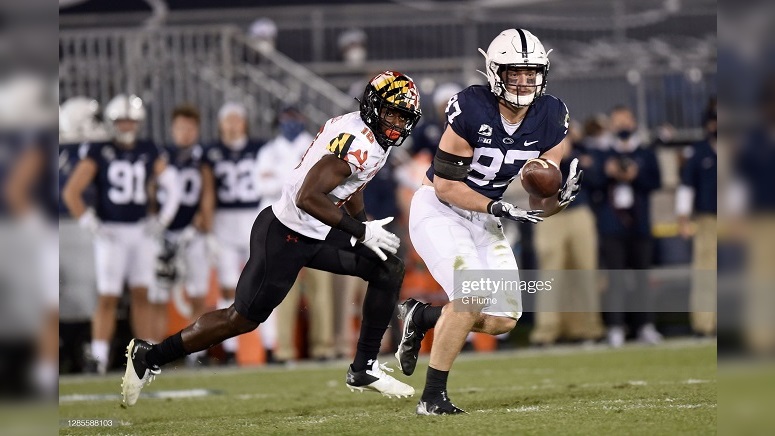With the 55th selection in the 2021 NFL Draft, the Pittsburgh Steelers selected Pat Freiermuth out of Penn State Freiermuth was widely regarded as the #2 TE prospect in this year’s draft class by most analysis and “draft experts” behind Kyle Pitts, who was selected #4 overall by the Atlanta Falcons. While Freiermuth isn’t the athletic marvel Pitts is in terms of a HWS specimen, he meets the needs the Steelers have envisioned for him, being that “throwback TE” the coaching staff and GM Kevin Colbert mentioned in the post-selection interview after making the pick.
During his time in Happy Valley, Freiermuth was often regarded as the focal point of the Nittany Lions’ passing attack. But what makes him a well-rounded prospect in today’s game is his ability in the blocking department. After doing more of a deep dive into this facet of his game, I came away higher on the selection than I initially was, and am excited to see how new OC Matt Canada’s offense uses him.
One thing that sticks out when watching Canada’s offensive system is the amount of motion he uses pre-snap. He requires his tight ends to transition across the LOS, either lining up attached to the line as a traditional TE or as an H-Back or split out in the slot. On this play, we see an example of the Maryland offense back in 2018 against Ohio State, where Canada is calling the shots and see the H-Back TE come across the line on the snap to pick up the edge defender.
We see the same usage of Freiermuth on these next few plays against Nebraska this year, where he lines up as the H-Back, then moves across the line to pick up the defender on the opposite side. Here he gets the stand-up outside linebacker closing down and seals him off from the runner gong off of his back, allowing the back to get to the second level untouched for the big run.
This second example in the same game we see Freiermuth come across the line on the snap of the football and lead up the hole for his back, finding the safety coming downhill in run support and kicking him out of the play, running him toward the sideline with his feet churning while putting his helmet into the defender and keeping his hands inside his chest as the runner gets the yardage for the first down.
Occasionally Freiermuth will be used with a pulling offensive lineman to either seal the edge or kick out defenders on the outside when asked to come across the formation, as we see here on this play. He gets on his man fine but doesn’t square him up and allows the defender to get through his outside shoulder and be in position to make the play.
Now Canada also utilized his TEs in-line as well in a more traditional fashion in his offensive system. Often, they would be asked to crash down defenders in order to clear the outside or perform a kick-out block on a linebacker or corner, as we see on this rep to the right side of the formation to spring the back.
The nice thing is, Penn State utilized Freiermuth a lot this way as well. Here against the Cornhuskers, we see Freiermuth on the left side of the formation. He picks up the edge defender, kicking him out to make sure he doesn’t crash inside and disrupt the inside run. Now it is a little concerning to see Freiermuth get shed pretty easily due to his tendency to lunge forward on his blocks, but he completes his task of keeping his man away from the action.
We see a similar usage, yet similar problem here against Ohio State back in 2019 where Freiermuth aligns on the right side of the formation in-line and attempts to get the kick out block on #20 Pete Werner. Freiermuth is in great position and has his hands inside the defender’s torso, but he gets narrow and too tall on his block, allowing Werner to pull him down to the ground due to Freiermuth not having a great base and forward lean.
It’s great to see Freiermuth in position, however, and display a willingness to get physical at the point of attack in the run game. However, he will need to improve his leverage and lean less into his blocks to better sustain his blocks at the next level.
On this rep against the Buckeyes, Freiermuth aligns on the right side at the H-Back position and is asked to get the kick-out block on Pete Werner again. This time, while not having the same leg drive, Freiermuth does a good job of squaring up his block, playing with good base and leverage, and manages to seal and turn Werner’s shoulders away from the play, thus allowing the runner to go right off of Freiermuth’s backside. The runner doesn’t get the first down, but Freiermuth executes his assignment well.
While some scouts may say Freiermuth doesn’t play with a lot of want-to in the run game as a blocker, I would contest that statement. He has plenty of want-to as a run blocker, showing a willingness to stick his face in the fan and drive his legs on contact. Sure, he could be more consistent with his leg drive on a snap-to-snap basis, but the desire is there which is the key to improvement. We see that here in this clip against Maryland where Freiermuth aligns in the slot and picks up the safety coming downhill in the open field, driving his feet when he meets him and pushing him back a good 10 yards downfield until he finishes him into the ground for the takedown block.
Another thing to consider is that Freiermuth played through a shoulder injury for a majority of the 2020 season, likely causing him to not have the same power in his punch and lack the ability to sustain his blocks for long periods of time. Should his shoulder be fully healthy by the time the season rolls around as expected, Freiermuth should be good to go and be better able to sustain his block rather than playing with only one good arm.
Now when I conducted my own personal analysis of Freiermuth, I compared him to current Patriots TE Hunter Henry. Both have nearly identical frames in terms of height and size, are good yet not great athletes, and are fairly reliable options in the passing game. However, I wanted to compare the two in terms of blocking, and I came away rather surprised in the similarities in this area of their game as well. We see here Henry line up as the H-Back on the left side of the formation and come across the line for the block on the edge, cutting down the linebacker coming downhill rather than the kick-out block Freiermuth was asked to make, but still utilized in the same way to spring the runner to the outside.
On this play, we see Henry line up on the left side of the formation in-line (right side of the screen) and climb to the second level to pick up #54 Lavonte David and run him to the sideline. He shows the leg drive and the case of the forward lean that Freiermuth plays with as a blocker, suggesting that Freiermuth could likely be used in the same way as he develops his technique and overall positioning over his first couple seasons in the pros.
Overall, Freiermuth isn’t a devastating blocker that is going to maul defenders up front, but he has the desire, and has shown the ability to be utilized all over the formation that matches Canada’s previous offensive system to make the blocks asked of him as a slot receiver, H-Back, or traditional in-line TE. He will need to improve his forward lean and his strength at the point of attack to sustain his blocks, but he runs his feet on contact and should be able to hold his own against linebackers and defensive backs.
After watching more film, I now see that Freiermuth wasn’t just only drafted to be a big presence in the red zone or a security blanket over the middle of the field as a chain mover, but that he is likely directly in the plans to help revive the running game based on his current traits and room to develop as a great fit in Canada’s offensive system.








